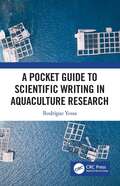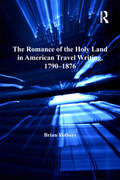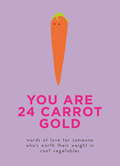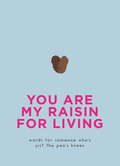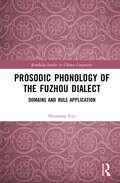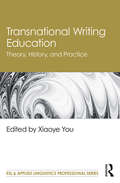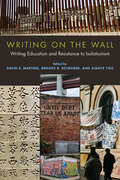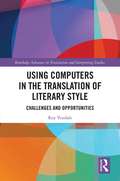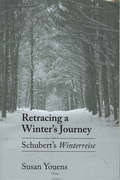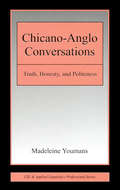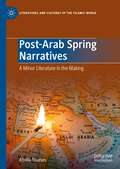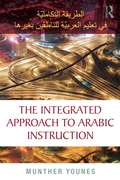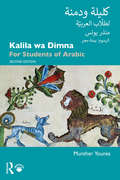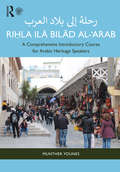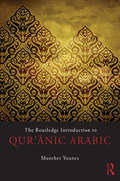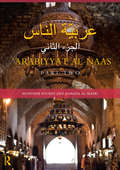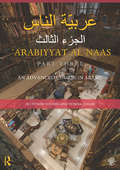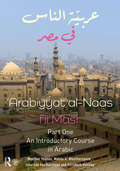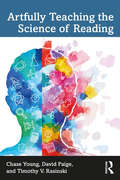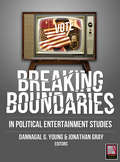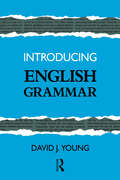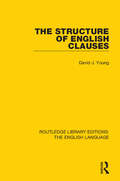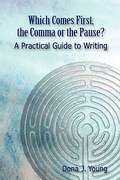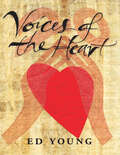- Table View
- List View
A Pocket Guide to Scientific Writing in Aquaculture Research
by Rodrigue YossaWriting for a high-quality scientific aquaculture publication is challenging, and many students and early career aquaculture scientists find the task daunting. Expanding on his popular workshop on Improving Scientific Writing at the 2017 World Aquaculture conference, Rodrigue Yossa provides new researchers with all the tools they need to write abstracts and a variety of articles (original, research reports, magazines, working papers, conference proceedings and more). He also takes the reader step-by-step through the process of reviewing submitted manuscripts and replying to reviewers, as well as understanding research ethics. Each section is accompanied by examples, and attention is focused on providing advice on grammar, how to focus your paper and possible loopholes when writing. A Pocket Guide to Scientific Writing in Aquaculture Research offers a lifeline to aquaculture students and early career researchers getting a grasp on the basics of science communication through writing.
The Romance of the Holy Land in American Travel Writing, 1790–1876
by Brian YothersThis book is the first to engage with the full range of American travel writing about nineteenth-century Ottoman Palestine, and the first to acknowledge the influence of the late-eighteenth-century Barbary captivity narrative on nineteenth-century travel writing about the Middle East. Brian Yothers argues that American travel writing about the Holy Land forms a coherent, if greatly varied, tradition, which can only be fully understood when works by major writers such as Twain and Melville are studied alongside missionary accounts, captivity narratives, chronicles of religious pilgrimages, and travel writing in the genteel tradition. Yothers also examines works by lesser-known authors such as Bayard Taylor, John Lloyd Stephens, and Clorinda Minor, demonstrating that American travel writing is marked by a profound intertextuality with the Hebrew and Christian scriptures and with British and continental travel narratives about the Holy Land. His concluding chapter on Melville's Clarel shows how Melville's poem provides an incisive critique of the nascent imperial discourse discernible in the American texts with which it is in dialogue.
You Are 24 Carrot Gold: Words of love for someone who's worth their weight in root vegetables
by You Are 24 Carrot GoldThere's always that one pearson who's the cherry on top, the cool beans, the pea's knees. Tell them they're amaizeing with this little book of upbeat and adorkable fruit puns. #squashgoalsAbout the seriesThis cute and colourful series of fruit-pun-filled gift books are the perfect pick-me-ups for you, your friend or your partner in crime. Do you need to avocuddle, or are you grapeful for someone who's a bit of a melon? Then share the clove with these little books: AvoCuddle, WhataMelon, You are my Raisin for Living, Don't Give a Fig, I am Grapeful, You are 24 Carrot Gold.*veg, nuts and seeds are fair game
You Are My Raisin for Living: Words for someone who's just the pea's knees
by You Are My Raisin For LivingWhen your heart is pumpkin for the one who holds the kiwi to your heart, let them know you clove them with this little book of upbeat and adorkable fruit puns. #callmemaypeaAbout the series This cute and colourful series of fruit-pun-filled gift books are the perfect pick-me-ups for you, your friend or your partner in crime. Do you need to avocuddle, or are you grapeful for someone who's a bit of a melon? Then share the clove with these little books: AvoCuddle, WhataMelon, You are my Raisin for Living, Don't Give a Fig, I am Grapeful, You are 24 Carrot Gold. *veg, nuts and seeds are fair game
Prosodic Phonology of the Fuzhou Dialect: Domains and Rule Application (Routledge Studies in Chinese Linguistics)
by Shuxiang YouProsodic Phonology of the Fuzhou Dialect: Domains and Rule Application is the first attempt to conduct a comprehensive analysis of the Fuzhou phonological system from the perspective of prosodic phonology. It addresses the following issues: What prosodic constituents exist in the Fuzhou dialect and what kinds of roles they play in the Fuzhou phonological system; how to define the domain formation of these prosodic constituents in the Fuzhou dialect; what kinds of Fuzhou phonological phenomena make crucial reference to these prosodic constituents as the domain of application; and what implications does the study of the Fuzhou phonological system have for the prosodic phonology theory. This book is a valuable text for students and scholars in the field of Chinese dialectology, Min dialects, prosodic phonology, and phonology-morphosyntax interface.
Transnational Writing Education: Theory, History, and Practice (ESL & Applied Linguistics Professional Series)
by Xiaoye YouArguing that writing teachers need to enable students to recognize, negotiate with, deconstruct, and transcend national, racial, ethnic, and linguistic boundaries, this volume proposes a "transnational" framework as an alternative approach to literacy education and as a vital component to cultivating students as global citizens. In a field of evolving literacy practices, this volume builds off the three pillars of transnational writing education—translingualism, transculturalism, and cosmopolitanism—and offers both conceptual and practice-based support for scholars, students, and educators in order to address current issues of inclusion, multilingual learning, and diversity.
Writing on the Wall: Writing Education and Resistance to Isolationism
by Xiaoye You David S. Martins Brooke R. SchreiberThe first concerted effort of writing studies scholars to interrogate isolationism in the United States, Writing on the Wall reveals how writing teachers—often working directly with students who are immigrants, undocumented, first-generation, international, and students of color—embody ideas that counter isolationism. The collection extends existing scholarship and research about the ways racist and colonial rhetorics impact writing education; the impact of translingual, transnational, and cosmopolitan ideologies on student learning and student writing; and the role international educational partnerships play in pushing back against isolationist ideologies. Established and early-career scholars who work in a broad range of institutional contexts highlight the historical connections among monolingualism, racism, and white nationalism and introduce community- and classroom-based practices that writing teachers use to resist isolationist beliefs and tendencies. “Writing on the wall” serves as a metaphor for the creative, direct action writing education can provide and invokes border spaces as sites of identity expression, belonging, and resistance. The book connects transnational writing education with the fight for racial justice in the US and around the world and will be of significance to secondary and postsecondary writing teachers and graduate students in English, linguistics, composition, and literacy studies. Contributors: Olga Aksakalova, Sara P. Alvarez, Brody Bluemel, Tuli Chatterji, Keith Gilyard, Joleen Hanson, Florianne Jimenez Perzan, Rebecca Lorimer Leonard, Layli Maria Miron, Tony D. Scott, Kate Vieira, Amy J. Wan
Using Computers in the Translation of Literary Style: Challenges and Opportunities (Routledge Advances in Translation and Interpreting Studies)
by Roy YoudaleThis volume argues for an innovative interdisciplinary approach to the analysis and translation of literary style, based on a mutually supportive combination of traditional close reading and ‘distant’ reading, involving corpus-linguistic analysis and text-visualisation. The book contextualizes this approach within the broader story of the development of computer-assisted translation -- including machine translation and the use of CAT tools -- and elucidates the ways in which the approach can lead to better informed translations than those based on close reading alone. This study represents the first systematic attempt to use corpus linguistics and text-visualisation in the process of translating individual literary texts, as opposed to comparing and analysing already published originals and their translations. Using the case study of his translation into English of Uruguayan author Mario Benedetti’s 1965 novel Gracías por el Fuego, Youdale showcases how a close and distant reading approach (CDR) enhances the translator’s ability to detect and measure a variety of stylistic features, ranging from sentence length and structure to lexical richness and repetition, both in the source text and in their own draft translation, thus assisting them with the task of revision. The book reflects on the benefits and limitations of a CDR approach, its scalability and broader applicability in translation studies and related disciplines, making this key reading for translators, postgraduate students and scholars in the fields of literary translation, corpus linguistics, corpus stylistics and narratology.
Retracing a Winter's Journey: Franz Schubert's "Winterreise"
by Susan YouensI like these songs better than all the rest, and someday you will too, Franz Schubert told the friends who were the first to hear his song cycle, Winterreise. These lieder have always found admiring audiences, but the poetry he chose to set them to has been widely regarded as weak and trivial. In Retracing a Winter's Journey, Susan Youens looks not only at Schubert's music but at the poetry, drawn from the works of Wilhelm Müller, who once wrote in his diary, "perhaps there is a kindred spirit somewhere who will hear the tunes behind the words and give them back to me!"Youens maintains that Müller, in depicting the wanderings of the alienated lover, produced poetry that was simple but not simple-minded, poetry that embraced simplicity as part of its meaning. In her view, Müller used the ruder folk forms to give his verse greater immediacy, to convey more powerfully the wanderer's complex inner state. Youens addresses many different aspects of Winterreise: the cultural milieu to which it belonged, the genesis of both the poetry and the music, Schubert's transformation of poetic cycle into music, the philosophical dimension of the work, and its musical structure.
Chicano-Anglo Conversations: Truth, Honesty, and Politeness (ESL & Applied Linguistics Professional Series)
by Madeleine YoumansThis groundbreaking book--about differences in communication practices between Mexican-American underclass residents in an East Los Angeles housing project and white, middle-class literacy tutors who worked with them--makes an important contribution to research on the sociolinguistics of the Chicano gang culture. More specifically, this work adds substantially to research on understanding linguistic politeness theories, the use of epistemic modals for negative politeness, and evidentiality. It refines, and in a number of cases, defines, function categories for epistemic modals through a rigorous grammatical analysis. This book is also distinctive in that the author subjects the language of middle-class Anglos to the same type of scrutiny that is often reserved for non-mainstream groups. Youmans contends that the differences between the Chicano and Anglo speakers are the result of the two groups’ different sociocultural circumstances, including historical and current living and working patterns and the relative value placed on familialism and communalism versus individualism and independence. (The terms Chicano and Anglo are used as a kind of shorthand in this book--not to raise larger sociocultural issues implied by these terms.) Although the number of participants in the study limits the applicability of the findings as they might be extrapolated to all Chicanos/as, or all Anglos when reporting sociolinguistic observations, the main argument advanced is that language use may provide insights into beliefs, attitudes, and practices in the larger society. This volume is directed to researchers and graduate students in the areas of sociolinguistics, applied linguistics, discourse analysis, and cross-cultural communication, and will also interest language and linguistics educators and grammarians.
Post-Arab Spring Narratives: A Minor Literature in the Making (Literatures and Cultures of the Islamic World)
by Abida YounasThis book looks at eight post Arab Spring novels in the context of Gilles Deleuze’s and Félix Guattari’s theory of minor literature. Ahdaf Soueif, Hisham Matar, Karim Alrawi, Youssef Rakha, Yasmine El Rashidi, Omar Rober Hamilton, Saleem Haddad, and Nada Awar Jarrar all focus on the Arab world in their work; on the lives of ordinary and minority peoples; and on the revolutions of their respective nations. This volume shows how these contemporary Anglo-Arab novelists exhibit linguistic experimentation akin to Deleuze’s and Guattari’s theory of ‘deterritorialization’, but in a way that is unique to Anglo-Arab writing. The selected novelists repudiate the use of metamorphosis, which is usually an essential part of the deterritorialization of a major language. Instead, their writings enact the minor practice of linguistic deterritorialization by using metaphor and by incorporating contemporary modes of protest like popular slogans, tweets, and chants. These authors challenge the conventions of minor literature and, by adopting this mode of deterritorialization, foreground the experiences of officially silenced voices.
The Integrated Approach to Arabic Instruction
by Munther YounesLeading teacher of Arabic, Munther Younes, explores the realities of teaching Arabic as a foreign language (AFL) and outlines his groundbreaking approach to instruction, tried and tested over many years at Cornell University. The Integrated Approach to Arabic Instruction introduces teachers to the features of an integrated Arabic program—one that simultaneously teaches the two varieties of the language, Modern Standard Written Arabic, fuṣḥā, and the dialect, āmmiyya, in a way that reflects the authentic practice of native Arabic speakers. This pedagogy, Younes argues, is the most logical, effective and economical method of instruction as it prepares students fully for the realities of the Arabic diglossic situation. Younes takes teachers through the following ground: Consideration of the current Arabic sociolinguistic situation and key debates in the field Outline of changing student goals and the needs of the modern AFL learner Overview of the Integrated Approach covering its rationale, features, implementation methods and usage of instructional materials in the classroom Response to objections to the Integrated Approach, outlining its advantages over alternative practices and clarifying crucial issues in practice The Integrated Approach to Arabic Instruction addresses a pressing issue deeply relevant to the world of Arabic language instruction, placed in the practical context of shifting attitudes among students and educators. It will be an essential resource for all teachers of Arabic as a Foreign Language.
Kalila wa Dimna: For Students of Arabic
by Munther YounesSpecifically designed for students of Arabic, this fully illustrated rendition of the Arabic literary classic enhances students’ reading, listening, speaking, and writing skills through the medium of these fun, engaging, and culturally relevant tales. The first part of this second edition follows the original order of the stories, with new vocabulary explained in footnotes throughout. In the second part, grammar explanations and a wealth of exercises provide ample opportunities for readers to improve their understanding of the stories and strengthen their command of Arabic grammar and Arabic writing. The audio material, containing the texts of the stories read by native speakers, is available to download free online to help develop the learner’s listening skills. Suitable for both class use and independent study, Kalila wa Dimna: for Students of Arabic is a must for all intermediate to advanced students wishing to enhance their language skills and discover one of the most popular pieces of Arabic literature ever written.
Riḥla ilā Bilād al-‘Arab رحلة إلى بلاد العرب: A Comprehensive Introductory Course for Arabic Heritage Speakers
by Munther YounesRiḥla ilā Bilād al-‘Arab starts with the Arabic alphabet and gradually and systematically builds the reading and writing skills and mastery of Fuṣḥā grammar. As students develop their reading, writing, and grammar skills, they will be learning about Arab history, society, and culture. This book contextualizes Arabic grammar teaching with sufficient and relevant drills and exercises. Added personal and cultural interest is given by the diary of Amal, an American student of Arab descent, who travels to Jordan and Palestine. This textbook includes maps, illustrations, and photographs and is accompanied by audio on the companion website that can be viewed here: www.routledge.com/cw/younes . The book is designed for Arabic heritage students—students who can understand and speak an Arabic dialect (Egyptian, Iraqi, Moroccan, etc.) but are unfamiliar with Modern Standard Arabic, known as Fuṣḥā.
The Routledge Introduction to Qur'anic Arabic
by Munther YounesThe Routledge Introduction to Qur’ānic Arabic is an innovative, text-based, language course designed for students interested in acquiring a foundation in Qur’ānic and Classical Arabic. Focused on enhancing comprehension and vocabulary acquisition, the book contains 40 lessons designed to be covered in about 40 hours of classroom instruction. Starting with the shorter sūras of the Qur’ān, such as al-Fatiha and those of the Juz’ ‘Amma, it utilizes their recurring vocabulary and grammatical structures to build a stable linguistic foundation for learners before moving on to more challenging and longer sūras such as Yāsīn, Maryam and Yūsuf. Although the book is primarily designed for classroom use, the vocabulary and structures of the short sūras, the accompanying audio recordings, and the activities found throughout the book will also be helpful for independent learners. The only prerequisite is knowledge of the Arabic writing system. The audio material, which is available on the Routledge website, helps learners improve their pronunciation of individual sounds and develop their skills to syllabify Arabic words and phrases correctly in order to approximate that of native speakers. Also available on the website are answer keys to exercises and transcriptions of the audio material. Written by an experienced teacher, The Routledge Introduction to Qur’ānic Arabic is an essential guide for instructors, students and anyone interested in developing their knowledge of Qur’ānic Arabic.
Arabiyyat al-Naas (Part Two): An Intermediate Course in Arabic
by Munther Younes Hanada Al-MasriArabiyyat al Naas (Part Two): An Intermediate Course in Arabic offers a vibrant course in Arabic as it is written and spoken today by educated native speakers. Not only does it continue the innovative integration of Modern Standard Arabic (MSA) and Levantine Arabic used in Part One of the series, but it does so in a way that supports and develops students’ increased mastery of the language. Combining a greater focus on cultural topics with an increased coverage of MSA, Part Two introduces more sophisticated communication, giving students a deeper awareness of the cultural base of the Arabic language. Features include: Twenty-one theme-based units covering a wide range of relevant and engaging topics, including education and learning, jobs and professions, the Arab woman, religion, money and the economy, politics and government and the environment Thorough coverage of listening, speaking, writing and reading skills in every unit, with lessons structured to provide students with variety, stimulation and further opportunities for practice Humorous, realistic dialogues reflecting everyday educated speech among Arabs to build up strong and practical communication skills A rich variety of reading passages, including poems, short stories, newspaper articles, descriptions of Arab cities and biographies of famous figures, designed to improve comprehension and analytical skills and to deepen students’ knowledge of Arab history, culture, language, and literature An extensive range of appealing exercises and activities, including crossword puzzles, root-and-pattern identification exercises, passage completions, guided and free compositions, and songs Free accompanying CD that includes audio recordings of the listening materials in the 21 units and a number of songs tied to their themes Free companion website (www.routledge.com/cw/younes) featuring the texts of the listening passages, the audio recordings available on the CD , a track list of all the audio materials, the answer keys to the crossword puzzles, sample tests and language games. Developed by an experienced and dynamic author team and tested over a number of years at Cornell University, Arabiyyat al Naas (Part Two) will be an essential resource for intermediate-level students of Arabic. While primarily designed for classroom use, the accessibility of the course also renders it highly suitable for independent study. This volume is the second in a pioneering three-part series of Arabic textbooks which together provide a complete three-year undergraduate language program.
Arabiyyat al-Naas (Part Three): An Advanced Course in Arabic
by Munther Younes Yomna Chami‘Arabiyyat al-Naas (Part Three): An Advanced Course in Arabic builds further on the groundbreaking approach used in Part One and Part Two of the series. It integrates Modern Standard Arabic (MSA) and spoken Levantine in a way specially tailored to the needs of advanced students. Levantine Arabic strongly features in spoken discussions of MSA materials, reflecting authentic practice by native speakers. However, the overall ratio of MSA – the form employed for reading, writing and formal speaking in the Arab world – to Levantine has been increased, supporting students’ mounting need for MSA as they progress further in their education. This textbook is designed to take learners from the Advanced Low to the Advanced High level according to the ACTFL criteria, and from level B2 to C1 on the CEFR proficiency scales. Features include: 18 theme-based units covering topics such as Arab minorities; education; religion; love and marriage; the Arab woman; economics; politics; military matters; and the environment thorough coverage of listening, speaking, reading, and writing skills with clear grammar explanations and lessons structured to provide opportunities for further practice humorous, realistic dialogues reflecting educated speech among Arabs, to build up strong and practical communication skills attention to issues highly relevant to modern Arab society, encouraging active engagement with the course and further exploration of the themes a rich variety of reading passages from contemporary sources such as Al Jazeera as well as excerpts from the classic works One Thousand and One Nights and Kalila wa Dimna an extensive range of stimulating exercises and activities, including crossword puzzles, root-and-pattern identification exercises, passage completions, and free compositions free companion website (www.routledge.com/cw/younes) with the audio tracks, and texts of the listening passages and answer key. Developed by a dynamic author team and tested over a number of years at Cornell University, ‘Arabiyyat al-Naas (Part Three) is an essential resource for advanced-level students of Arabic. While primarily designed for classroom use, the accessibility of the course also renders it highly suitable for independent study. This volume is the final installment of a pioneering three-part series of Arabic textbooks which together provide a complete three-year undergraduate language program. Munther Younes and Yomna H. Chami both teach Arabic at Cornell University, USA.
Arabiyyat al-Naas fii MaSr (Part One): An Introductory Course in Arabic
by Munther Younes Makda Weatherspoon Elizabeth Huntley Jonathan Featherstone‘Arabiyyat al-Naas fii MaSr (Part One) offers a ground-breaking introduction to Arabic as it is written and spoken by native speakers. It combines a progressive and rigorous grounding in Modern Standard Arabic (MSA), the register employed for reading, writing and formal speaking, with an innovative integration of the dominant Egyptian variety. Introducing the two simultaneously and seamlessly building on their shared features, ‘Arabiyyat al-Naas fii MaSr (Part One) uses each in its proper context: Egyptian dialect for conversations and MSA for reading and writing activities. In this way, the course efficiently prepares students for the practical realities of learning and living Arabic today. Features include: Expanded grammar explanations and activation drills, including discussions about colloquial and formal similarities and differences A series of authentic video-clips recorded in Egypt to help learners revise the vocabulary and structures then learn unit by unit Extensive classroom activities and homework exercises that provide constant review to reinforce learning Arabic-English and English-Arabic glossaries, reference charts, and a grammar index Songs with simple lyrics tied to the themes of the course to help advance vocabulary acquisition and understanding of basic grammatical structures A companion website (www.routledge.com/cw/weatherspoon) that features fully integrated interactive, self-correcting exercises, audio and video materials, and additional online course management and grading options for teachers A user-friendly and vibrant text design with full colour, richly illustrated throughout with over two hundred illustrations and photos A teachers manual with an Arabic introduction for the teacher, which lays out the structure of the student course book, its methodology and directions and suggestions for its use. Written by experienced teachers of Arabic and experts in Arabic teaching pedagogy, ‘Arabiyyat al-Naas fii MaSr (Part One) is an essential resource for students beginning to learn Arabic.
Artfully Teaching the Science of Reading
by Chase Young David Paige Timothy V. RasinskiThis inviting book is a bridge between two major strands of reading instruction that are often held in opposition: the science of reading and artful approaches to teaching reading. Although the current climate of literacy instruction positions these approaches as diametrically opposed, the authors Young, Paige, and Rasinski describe how teachers can use the science of reading to engage students in artful, engaging, and authentic instruction. The authors reveal how effective teaching is a dynamic process that requires agency and creativity and show how teachers make artful shifts based on the needs of students in specific contexts. Chapters include a range of examples and explanations of how artful teaching is integrated into reading instruction and how it can increase students’ motivation and positive attitudes toward reading. The concise and practical chapters cover key topics, including phonemic awareness, reading fluency, vocabulary, assessment, home and family reading, and more. This essential road map for all pre-service and in-service reading teachers restores the importance of teacher agency, supports the critical understanding of reading research, and allows teachers to use their knowledge, experience, and creative approaches in the classroom. This is the definitive guide to teaching reading as both an art and a science.
Breaking Boundaries: In Political Entertainment Studies
by Dannagal G. Young Michael X. Delli Carpini Lauren Feldman Megan R. Hill Geoffrey Baym Heather Lamarre Larry Gross Roderick P. Hart Amber Day Jeffrey P. Jones R. Lance Holbert Paul R. Brewer Jonathan Gray Arlene Luck Lindsay HoffmanThis book brings together a collection of scholars whose work is leading the field of political entertainment studies, and yet it crosses methodological divides to do so, with quantitative and critical/cultural perspectives both represented. Indeed, each author worked as a part of a pair, addressing a similar topic as a colleague from across the divide. The result is a series of essays that add to and move beyond the state of political entertainment research--not only in content, but also in approach--by challenging readers to expand their thinking on these topics outside of the regular strictures. It begins with direct discussion of methodological divides in the field, as Michael Delli Carpini and Jeffrey P. Jones offer an essay, response, and further response. Following this initial, explicit tackling of methodology and what is at stake, Geoffrey Baym and Lindsay Hoffman each examine partisan language and interviews in The Daily Show with Jon Stewart and The Colbert Report, respectively; Lauren Feldman and Paul Brewer examine satirical treatments of science; Amber Day and Heather LaMarre address the importance of Stephen Colbert's Super PAC; Dannagal G. Young and Roderick Hart discuss The Daily Show's treatment of political participation, citizenship, and social protest; and finally, Megan Hill and R. Lance Holbert each wrestle with developing a normative approach to political satire. Read what scholars think!
Introducing English Grammar
by David J. YoungIntroducing English Grammar provides a basic grounding in English grammar, without going into too much detail or theory, and will lay the foundation for further grammatical studies. David Young presents English grammar in a coherent and lively way. He dispels the popular notion among students that grammar is simply a set of dreary rules and argues for the importance of grammar in describing the structure and function of language itself. Exercises are provided at the end of each chapter and the book includes integrated diagrams and a glossary of technical terms at the back of the book.
The Structure of English Clauses (Routledge Library Editions: The English Language #29)
by David J. YoungFirst published in 1980, this book provides a clear and practical introduction to a wide variety of English structures. It concentrates on a large and crucial area of English grammar, which covers units of higher rank than words, and structures that have verbs rather than nouns as their nuclear elements. Throughout the book, David Young focuses on the English language as it is actually spoken. At every point his discussion of syntax is closely integrated with meaning, and he pays particular attention to the ways in which speakers of English signal their intensions. The author points out how verbal patterning is meaningful, and outlines the criteria used by grammarians to distinguish one structure from another. The result is an analytical framework that can be applied to any real-life text in order to understand its structure. This is a book that will encourage a realistic, exploratory and investigative attitude towards the English language.
Sonnets to Orpheus (Wesleyan Poetry in Translation)
by David Young Rainer Maria RilkeSonnets to Orpheus is Rainer Maria Rilke's first and only sonnet sequence. It is an undisputed masterpiece by one of the greatest modern poets, translated here by a master of translation, David Young.Rilke revived and transformed the traditional sonnet sequence in the Sonnets. Instead of centering on love for a particular person, as has many other sonneteers, he wrote an extended love poem to the world, celebrating such diverse things as mirrors, dogs, fruit, breathing, and childhood. Many of the sonnets are addressed to two recurrent figures: the god Orpheus (prototype of the poet) and a young dancer, whose death is treated elegiacally.These ecstatic and meditative lyric poems are a kind of manual on how to approach the world - how to understand and love it. David Young's is the first most sensitive of the translations of this work, superior to other translations in sound and sense. He captures Rilke's simple, concrete, and colloquial language, writing with a precision close to the original.
Which Comes First, the Comma or the Pause: A Practical Guide to Writing
by Dona J. YoungDo Commas matter? You be the judge. Oscar Wilde illustrated the confusion about commas and pauses perfectly when he said, "I have spent most of the day putting in a comma and the rest of the day taking it out." If you are basing your writing decisions on guesses, now is the time to stop the uncertainty-it is costing you too much time, effort, and credibility. This book takes the mystery out of how to produce good writing by untangling core concepts and making them easy to learn. Here is a promise: Read this book from cover to cover, and you will bring your writing to a higher level. You will get your ideas down quickly and then edit like a pro.
Voices of the Heart
by Ed YoungIn this deeply personal book, artist and author Ed Young explores twenty-six Chinese characters, each describing a feeling or emotion, and each containing somewhere the symbol for the heart. Through stunning collage art that interprets the visual elements within each character, Young uncovers layers of emotional meaning for words such as joy and sorrow, respect and rudeness. He invites children to probe the full range of their own emotions, and gives parents, librarians, and older readers a context for discussing ethics and for examining the silmilarities and differences between old and new, East and West. Voices of the Heart is a truly unique exploration—or as Young writes, "adventure"—into the different moods, and dangers and abilities of the human heart.
